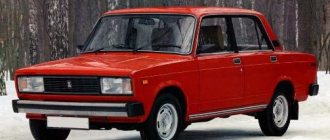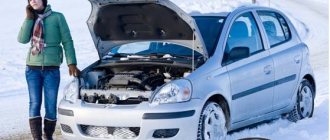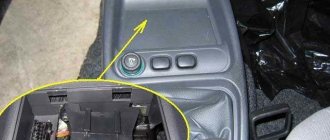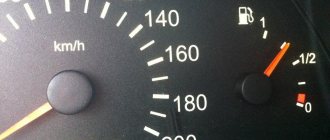We live in a northern country and even in the middle zone it is frosty from October to March. Cold weather brings many problems, including increased fuel consumption.
In the north there is a whole school of survival and using a car in the cold. For example, double glazing - ordinary glass cannot be warmed up in severe frosts; it freezes. If there is no warm garage, then in some regions drivers do not turn off the engine at all: they started it in the fall and turned it off in the spring.
But even in the middle zone, the car has a very good appetite in the cold. Why does fuel consumption increase in winter?
Warming up the engine
The instructions for modern cars say directly: warming up is not needed. However, this point was made to please environmentalists and professional motorists do not agree with it. Fuel consumption when warming up the engine in winter drains the tank faster than usual, but repairs will cost more. In cold weather, the oil thickens and its lubricating properties are lost. When the engine is cold, it works under load and wears out more. It is better to choose a middle ground: let the engine warm up slightly and only then hit the road. At low temperatures this will take about three minutes; as the temperature drops, the warm-up time increases.
Warming up helps get rid of foggy windows that are unsafe to drive with.
Increased fuel consumption in winter has been studied repeatedly and experiments have been carried out. The option with prolonged engine warm-up definitely loses. Options with short-term engine idling and without it at all are virtually equivalent from the point of view of fuel economy: during a cold start, the engine runs on a rich mixture and still part of the fuel does not burn out completely.
Therefore, the only economical and safe option for the engine is to warm up to a quarter of the operating temperature and move quietly without sudden acceleration. Of course, you must use motor oil that does not thicken in cold weather.
Winter odds table
Every year, the Ministry of Transport publishes a table of winter coefficients, which accountants use in calculating fuel consumption during the cold season.
| N pp | Regions of Russia (by federal districts) | Number of months and validity period of winter allowances | Maximum amount of winter allowances no more than, % |
| I. Central | |||
| 1 | Moscow | 5.0 01.11-31.03 | 10 |
| 2 | Belgorod region | 4.0 15.11-15.03 | 7 |
| 3 | Bryansk o. | 5.0 01.11-31.03 | 10 |
| 4 | Vladimir region | 5.0 01.11-31.03 | 10 |
| 5 | Voronezh region | 5.0 01.11-31.03 | 10 |
| 6 | Ivanovo region | 5.0 01.11-31.03 | 10 |
| 7 | Kaluzhskaya o. | 5.0 01.11-31.03 | 10 |
| 8 | Kostroma region | 5.0 01.11-31.03 | 10 |
| 9 | Kursk region | 5.0 01.11-31.03 | 10 |
| 10 | Lipetsk region | 5.0 01.11-31.03 | 10 |
| 11 | Moscow o. | 5.0 01.11-31.03 | 10 |
| 12 | Oryol region | 5.0 01.11-31.03 | 10 |
| 13 | Ryazan region | 5.0 01.11I-31.03 | 10 |
| 14 | Smolenskaya o. | 5.0 01.11-31.03 | 10 |
| 15 | Tambov o. | 5.0 01.11-31.03 | 10 |
| 16 | Tver region | 5.0 01.11-31.03 | 10 |
| 17 | Tula region | 5.0 01.11I-31.03 | 10 |
| 18 | Yaroslavskaya o. | 5.0 01.11-31.03 | 10 |
| II. Northwestern | |||
| 19 | Saint Petersburg | 5.0 01.11-31.03 | 10 |
| 20 | Republic of Karelia | 5.5 01.11-15.04 | 12 |
| 21 | Komi Republic | 6.0 01.11-30.04 | 15 |
| Vorkuta with the adjacent administrative region | 6.5 15.10-30.04 | 15 | |
| 22 | Arkhangelsk region (without Nenets Autonomous Okrug) | 6.0 01.11-30.04 | 15 |
| 23 | Vologda o. | 5.0 01.11-31.03 | 10 |
| 24 | Kaliningrad region | 4.0 15.10-15.03 | 7 |
| 25 | Leningrad region | 5.0 01.11-31.03 | 10 |
| 26 | Murmansk o. | 6.0 01.11-30.04 | 15 |
| 27 | Novgorod region | 5.0 01.12-31.03 | 10 |
| 28 | Pskov region | 5.0 01.12-31.03 | 10 |
| 29 | Nenets a.o. | 6.0 15.10-15.04 | 18 |
| III. North Caucasian | |||
| 30 | Republic of Adygea | 3.0 01.12-01.03 | 5 |
| 31 | The Republic of Dagestan | 3.0 01.12- 01.03 | 5 |
| 32 | The Republic of Ingushetia | 3.0 01.12- 01.03 | 5 |
| 33 | Chechen Republic | 3.0 01.12- 01.03 | 5 |
| 34 | Kabardino-Balkarian Republic | 3.0 01.12-01.03 | 5 |
| 35 | Republic of Kalmykia | 5.0 15.10-15.03 | 10 |
| 36 | Karachay-Cherkess Republic | 3.0 01.12-01.03 | 5 |
| 37 | Republic of North Ossetia-Alania | 3.0 01.12- 01.03 | 5 |
| 38 | Krasnodar region | 3.0 01.12- 01.03 | 5 |
| 39 | Stavropol region | 3.5 01.12-15.03 | 5 |
| 40 | Astrakhan region | 5.0 15.10-15.03 | 10 |
| 41 | Volgograd region | 5.0 15.10-15.03 | 10 |
| 42 | Rostov region | 4.0 15.11-15.03 | 7 |
| IV. Privolzhsky | |||
| 43 | Republic of Bashkortostan | 5.5 01.11-15.04 | 12 |
| 44 | Mari El Republic | 5.0 01.11-31.03 | 10 |
| 45 | The Republic of Mordovia | 5.0 01.11-31.03 | 10 |
| 46 | Republic of Tatarstan | 5.0 01.11-31.03 | 10 |
| 47 | Udmurt republic | 5.0 01.11-31.03 | 10 |
| 48 | Chuvash Republic | 5.0 01.11-31.03 | 10 |
| 49 | Kirov region | 5.5 15.10-31.03 | 12 |
| 50 | Nizhny Novgorod region | 5.0 01.11-31.03 | 10 |
| 51 | Orenburg region | 6.0 15.10-15.04 | 15 |
| 52 | Penza region | 5.0 01.11-31.03 | 10 |
| 53 | Perm region (without Komi-Permyatsky a.o.) | 5.5 01.11-15.04 | 10 |
| 54 | Samara region | 5.0 01.11-31.03 | 10 |
| 55 | Saratov region | 5.0 01.11-31.03 | 10 |
| 56 | Ulyanovsk region | 5.0 01.11-31.03 | 10 |
| 57 | Komi-Permyatsky a.o. | 6.0 15.10-15.04 | 18 |
| V. Ural | |||
| 58 | Kurgan region | 5.5 01.11-15.04 | 10 |
| 59 | Sverdlovsk region. | 5.5 01.11-15.04 | 10 |
| 60 | Tyumen region (without Khanty-Mansiysk and Yamalo-Nenets Autonomous Oblast) | 5.5 01.11-15.04 | 12 |
| 61 | Chelyabinsk region | 5.5 01.11-15.04 | 10 |
| 62 | Khanty-Mansi Autonomous Okrug | 6.5 15.10-30.04 | 18 |
| 63 | Yamalo-Nenets a.o. | 6.5 15.10-30.04 | 18 |
| VI. Siberian | |||
| 64 | Altai Republic | 5.5 01.11-15.04 | 15 |
| 65 | The Republic of Buryatia | 6.0 01.11-30.05 | 18 |
| 66 | Republic of Tuva | 6.0 01.11-30.04 | 18 |
| 67 | The Republic of Khakassia | 6.0 01.11-30.04 | 18 |
| 68 | Altai region | 5.5 01.11-15.04 | 15 |
| 69 | Krasnoyarsk Territory (without Taimyr and Evenki Autonomous Okrug) | 5.5 01.11-15.04 | 15 |
| 70 | Irkutsk region (without Ust-Orda Buryat Autonomous Okrug) | 6.0 01.11-30.04 | 18 |
| 71 | Kemerovo region. | 6.0 01.11-30.04 | 15 |
| 72 | Novosibirsk region | 5.5 01.11-15.04 | 12 |
| 73 | Omsk region | 5.5 01.11-15.04 | 12 |
| 74 | Tomsk region | 5.5 01.11-15.04 | 12 |
| 75 | Chita region (without Aginsky Buryat Autonomous Okrug) | 6.0 01.11-30.04 | 18 |
| 76 | Taimyrsky a.o. | 7.0 15.10-15.05 | 18 |
| 77 | Ust-Ordynsky Buryat a.o. | 6.0 01.11-30.04 | 18 |
| 78 | Evenki a.o. | 7.0 15.10-15.05 | 18 |
| 79 | Aginsky Buryat a.o. | 6.0 01.11-30.04 | 18 |
| VII. Far Eastern | |||
| 80 | Republic of Sakha (Yakutia) (without Chukotka Autonomous Okrug) | 7.0 15.10-15.05 | 20 |
| 81 | Primorsky Krai | 5.5 01.11-15.04 | 12 |
| 82 | Khabarovsk region | 5.5 01.11-15.04 | 12 |
| Okhotsk region | 6.5 15.10-30.04 | 18 | |
| 83 | Amur region | 6.0 01.10-30.04 | 15 |
| 84 | Kamchatka region (without Koryak a.o.) | 6.0 01.11-30.04 | 15 |
| 85 | Magadan region | 6.5 15.1030.04 | 18 |
| 86 | Sakhalin region - southern part | 5.0 15.11-15.04 | 12 |
| Sakhalin region — northern part (above 50 north latitude) | 6.0 01.10-30.04 | 15 | |
| 87 | Jewish region | 5.5 01.10-15.04 | 12 |
| 88 | Koryaksky a.o. | 6.0 01.10-30.04 | 15 |
| 89 | Chukotka a.o. | 6.5 15.10-30.04 | 20 |
| 90 | Islands of the Arctic Ocean and seas | 7.0 01.10-31.05 | 20 |
| 91 | Crimean | 4.0 01.10-01.03 | 5 |
Energy consumption
In winter, the stove fan operates at full power, along with heated windows, seats, and much more. When the windows fog up, you have to turn on the air conditioning. All these devices require energy, the production of which requires fuel. The battery charge decreases and the generator is actively working.
In the summer, of course, a lot of electricity is spent on the operation of the air conditioner, but in our summer it is turned on less often than the stove and various heating systems in our winter. Only the most frost-resistant ones will be able to save, and it’s difficult to call saving ten liters per season.
What can I do to improve my cold weather fuel economy?
You can't make your car's fuel consumption the same in winter as it is in summer. But, nevertheless, any of you will be able to achieve an effective reduction in fuel consumption in winter, which will allow you to save money. Here are some tips on how you can achieve lower fuel consumption:
— Leave your car in a warm place. For example, in your warm garage (or rent a warm garage for the winter) or in a paid, covered, warm parking lot. This way, every morning, your engine will need much less energy to heat all the fluids to the optimal temperature.
— Do not warm up the engine at idle for too long. Try to warm up the engine while driving at low speeds. In this mode, you will not only save fuel, but also achieve faster heating of the engine to operating temperature. Please note that most modern cars do not require the engine to warm up while idling. Nowadays, many automakers recommend moving away 30 seconds after starting the power unit.
— Do not use auxiliary heaters and defrosters more than necessary
— Using satellite navigation, choose the best routes to avoid traffic jams
— Check tire pressure regularly
— Use the type of oil recommended by the manufacturer for cold weather
— Remove car accessories that increase air resistance. For example, a trunk that you do not use every day.
— If you own a hybrid or electric car in severe frost, try not to use car chargers for your phone, navigator and other electronic gadgets. Also, if you eat in a mode that involves the operation of an electric motor, try not to turn on the heating stove at maximum temperatures.
— If you are driving a hybrid or electric car and the temperature outside is not too cold, then use electric seat heating instead of heating the interior.
— Clear your car of excess snow (especially on the roof), which significantly increases the weight of the car.
— Use only winter tires. If the tire tread has a lot of wear or the age of the tires exceeds 5 years, then be sure to buy new tires.
- Park the car in a place where the sun's rays warm the car body during the day
If you prefer to refuel your car with branded fuel with improved characteristics, then in winter it is better to fill in traditional brands of fuel, since improved gasoline or diesel fuel has many chemical additives, which can cause increased consumption in winter.
Vehicle motion resistance
In cold weather the car rolls worse. The grease in the bearings and gearbox thickens. When driving on a snowy road, the tires have to constantly make their way through the sticky snow. In cold weather, even the density of air increases.
At low temperatures, all factors begin to influence. As a result, the vehicle accelerates worse and retains less inertia.
Special winter lubricants for bearings, gearbox oils and gearboxes are not used in the middle zone for the reason that the replacement period for these products is long. It is expensive to update them before each season; they will not pay off.
Reducing carburetor consumption
A carburetor car is less economical than an injector, and therefore has more customization options regarding fuel consumption. But you shouldn’t be under the illusion that you can adjust the flow rate yourself, thanks to all these “twirls” on the carburetor. Without understanding the carburetor, you will get the opposite effect.
Timely replacement of spark plugs and good high-voltage wires can save your money. Improper sparking leads to incomplete combustion of gasoline, the remains of which simply fly out into the chimney. This also applies to correctly set ignition.
Tires
As temperatures drop, tire pressure decreases, which leads to increased tire wear and increases fuel consumption. Therefore, with the onset of cold weather, be sure to check the tire pressure and always keep it at the correct value.
Reducing the average speed in the city
The reasons for the increase in fuel consumption in winter are related to changes in traffic conditions. In megacities, the average speed in winter is lower than in summer. With the onset of cold weather, there are no fewer cars in a big city, snowfalls paralyze traffic, cars are even more stuck in traffic jams, either avoiding a traffic jam or waiting for a rescue grader. And all this against the backdrop of accidents here and there blocking traffic. At the same time, fuel consumption increases. A snowdrift that suddenly gets under your wheels can become a serious obstacle - winter conditions are difficult and not always predictable.
There are no significant differences between the seasons on the track. Unless the frosty air thickens and provides more resistance. But this affects high speeds.
From the point of view of fuel consumption, the optimal speed is 70-90 km/h. Further along the speedometer, air resistance becomes too great for economical driving. When the speed increases to 140-150 km/h, the car's appetite can double.
Additional items in the trunk
Many people increase the number of items carried in the trunk. There is a supply of anti-freeze, a shovel, and an additional tool. The car becomes heavier, fuel consumption increases.
In winter, in addition to the standard set of spare tire, jack and balloon, a shovel and additional tools are often prescribed in the trunk
In winter, in addition to the standard set of spare tire, jack and balloon, a shovel and additional tools are often prescribed in the trunk
Additional energy consumers
Heated seats, heated mirrors, rear, and often windshields waste additional energy, forcing the battery and generator to work under increased load. Having the heater on, and often the air conditioner (to dry the air in the cabin) also increases fuel consumption.
Heated seats increases the load, as it is an additional source of energy consumption in winter
Heated seats increases the load, as it is an additional source of energy consumption in winter
Why does the engine require more fuel in summer?
Fuel consumption is one of the factors that drivers pay attention to when purchasing a vehicle. It's no secret that gasoline begins to rise in price every year, but in terms of quality it remains in the same place.
There is a story among motorists that says that in the summer the engine consumes less gasoline. Allegedly, in cold weather he needs to warm up all the elements and connect the stove to work. But this is not true at all. Surely, some motorists have noticed that in summer, fuel consumption, on the contrary, is higher than in winter conditions. In addition, there are even special forums where beginners discuss this phenomenon. Let's look at why the engine asks for more fuel in hot weather.
The first factor that affects fuel consumption is heat. No driver or passenger wants to die from the heat in the cabin, so air conditioning is used in the summer. At the same time, very often it works in maximum mode. Note that this equipment, as a rule, takes about 10% of the power of the power plant. And here there is a logical explanation why consumption increases. The driver begins to press the gas pedal and feels that the power is no longer what it was before, so he presses more intensely. At the same time, precious liters are consumed much faster. Of course, some motorists open their windows in hot weather. They even agree to swallow the dust that constantly flies from the road and side of the road, just so as not to spend extra pennies on gasoline. However, not everyone knows that even in this case, fuel is consumed faster, and all because of aerodynamics, which is greatly reduced if the windows are open in the car.
Another factor affecting fuel consumption. In the summer, many people prefer to travel by car - it’s more profitable and much more interesting. On a good highway you can accelerate to 120 km/h, many manage even more without fear of traffic cameras. Here's another additional expense - it's no secret that fuel consumption depends on driving speed. Once you exceed the 120 km/h mark, the coefficient begins to grow rapidly.
Many car owners are faced with increased fuel consumption when they spend little time on their car. You all know that a car can last a long time and with high quality only in one case - if it is taken care of. Periodic checking of the body and elements under the hood is a mandatory ritual every morning. A more thorough inspection can be done on weekends. The elements that most need checking are filters. In the summer, they become clogged with midges, dust and dirt. If it is not replaced in time, it will supply little air and, accordingly, weak traction will appear - the driver will press the gas pedal harder.
Well, there is also good news for fans of extreme driving. In the summer, many drivers like to drive and perform sharp maneuvers. This is especially true of the younger generation, who have not even had time to tear themselves away from a bottle of milk, but are already holding the steering wheel in their hands and showing all their coolness. Sharp braking and starting are the main reasons for increased fuel consumption.
Bearings
Bearings are also susceptible to freezing, and in this case, torsion occurs with more significant force. These mechanisms heat up relatively quickly while driving, but initially consume much more energy than in the summer. Additionally, up to 2% of fuel is consumed.
Excessive fuel consumption also causes wheel bearing failure. If this element does not work correctly during a trip, then the wheel rotates with difficulty compared to a working bearing. To adjust the speed to the other wheels, the engine makes more effort, and the amount of fuel consumption increases, although not significantly.
Additional functions
Additional energy is spent on heating the seats, steering wheel, electrically heated mirrors, and the windshield, which ultimately adds 3-5% to the consumption.
You should also pay attention to the fact that starting the engine in frosty conditions does not occur as quickly as in warm weather. The battery is discharged more strongly when trying to start, and even when turned off, during cold weather, it holds a charge less well. To restore the nominal charge, the generator has to work longer, which entails fuel consumption.
Not the most obvious reason
In winter, air density changes. Moreover, the colder it is, the higher it is. At minus forty degrees it is 30% more than at plus thirty, and such a temperature range is quite realistic for some regions of Siberia. Accordingly, the higher the air density, the stronger the aerodynamic drag, which means the car needs more fuel to move at the same speed as in the summer.
- Winter is a special time for a car and its owner. Even ardent opponents of various “improvements” flock to stores for car heat, heated brushes and wheel belts.
Ways to reduce fuel consumption in winter
Engine
- Reducing the engine warm-up time at idle is a big contribution to saving gasoline. It is best to start driving immediately after reaching the minimum temperature that does not interfere with normal engine operation. When driving in low gears, the engine will warm up to operating temperature faster. And all lubrication units will also warm up faster while driving. But you can’t completely abandon warming up. It will be possible to achieve fuel savings, but the damage to the engine itself may be such that the savings will be negative. We need to look for a middle ground. When choosing an idle warm-up time, it is better to focus on the recommendations of the car manufacturer, as well as your own experience and the feel of your car. The best solution is to keep the car in a warm garage. At least the morning departure will take place without prolonged warm-up.
To save fuel in winter, it is recommended to warm up the car to a minimum temperature that does not interfere with normal engine operation.
- Take care of insulating the engine compartment. Modern “blankets” allow you to extend the cooling of the engine to the outside temperature for several hours. In some situations, this will allow you to do without idle warm-up altogether.
Insulating the engine compartment will also help save fuel
- Special winter oils are gradually being replaced by all-season ones. It may not be worth adding special oil in winter. But changing the oil before the winter season will be beneficial for the car. There is no need to wait until the scheduled date. The new oil will clearly make the engine work easier.
Tires
- Changing tires for winter conditions is more of a safety issue. Savings are secondary here, but they are also present. Yes, tires with winter tread are less economical than summer tires. But this is in equal conditions, and when driving on a good road. In winter, conditions are far from equal to those in summer, and the quality of the road is often much worse. This is where winter tires cover all their “disadvantages” and ultimately help save a lot of fuel. Driving on freshly fallen snow, reducing slippage, overcoming snowdrifts - this is where the superiority of winter tires is undeniable.
- It is important to remember to reduce tire pressure as temperatures drop. Do not increase the pressure to values outside the normal range. In winter, it is better to monitor this parameter more often.
Energy consumption
It’s not worth saving on heating the interior and rear window in winter. The work of these energy consumers is a severe necessity that cannot be avoided. But it is recommended to limit the inclusion of other energy consumers - for example, a sound system. Especially until the engine is fully warmed up and the battery is charged after starting.
To reduce fuel consumption, it is recommended to limit the energy consumption of systems that are not responsible for heating and safety, for example, sound.
Driving Character
Driving a car in winter is different from driving in summer. There is a lot of advice on this topic, but now we are only talking about saving fuel.
- A sudden start from a standstill must be avoided. The car may simply remain in place, skidding on inopportunely turned up ice.
- It is advisable to take a more responsible approach to choosing a route, avoiding traffic jams. Winter traffic jams are larger, so it’s better not to risk it, hoping that it will resolve soon.
- Pay close attention to the condition of the road, avoiding areas where the car may get stuck or skid.
- Don't park in the first place you come across. A small snowdrift or patch of ice can make it very difficult to get out.
Little things
- Fallen snow must be cleared not only from the car windows, but also from the roof and trunk. Excess weight means extra load on the machine.
- It’s worth considering whether a roof rack is needed in winter. On long trips, it “steals” fuel in the summer, and in winter this consumption increases.
- It is useful to inspect the trunk before the winter season. If possible, remove heavy and not very necessary items from it. A trifle, but it will be easier for the car. You don’t need to put the shovel away, but on the contrary, put it in the trunk and carry it around all winter. If you don’t need it, that’s good. But sometimes just a few swipes of a shovel can provide the car with a trouble-free exit from the problem area.
Most tips for reducing unwanted fuel consumption boil down to one thing: it’s difficult for a car in winter, and any help in its difficult work is welcome. Help your car even in small things - and it will thank you. Including a slight increase in fuel costs.
Summer and winter fuel consumption: difference, reasons, reduction in fuel consumption4.8 (96.67%) 6 votes
Advice
Buy a modern car in which, thanks to new design solutions, fuel consumption is not too dependent on external climatic conditions and the fact whether the car was warmed up before leaving or not. Modern cars have systems for warming up everything possible: the interior, windows, mirrors, seats, without starting the engine and wasting gasoline or diesel fuel.
In Europe, in cold countries, for example in Finland, in local parking lots there are special stationary devices to which you can connect a small stove and place it in the car. Warming up a car with electricity is much cheaper than with fuel. We are, of course, far from such convenience; we have to use the car’s own resources
Sources
- https://AutoClub174.ru/rekomendacii/rashod-benzina-zimoj-i-letom.html
- https://shassik.ru/salon/rashod-topliva-zimoj.html
- https://AutoLions.ru/sovety/pochemu-zimoj-rashod-benzina-bolshe.html
- https://favorit-motors.ru/articles/ekspluataciya-avto/uvelichilsya-rashod-topliva/
- https://1gai.ru/baza-znaniy/sovety/513508-ekonomiya-topliva-v-holodnuyu-pogodu.html
- https://avtoskill.ru/sovety/letniy-i-zimniy-rashod-topliva-raznitsa-prichinyi-snizhenie-rashoda-topliva.html
- https://dongfeng-auto.ru/sovety/na-skolko-zimoj-uvelichivaetsya-rashod-topliva.html
[collapse]
Regulatory regulation
The document that sets fuel consumption standards is order No. AM-23-r dated March 14, 2008. The recommended fuel consumption standards for 2022 are approved by the Ministry of Transport of the Russian Federation; the latest edition of the methodological recommendations was published in September 2018. Changes were made by order of the Ministry of Transport of the Russian Federation dated September 20, 2018 No. IA-159-r.
The Ministry of Transport recommends calculating the volume of gasoline consumed as follows:
- fuel consumption.
— base fuel consumption rate (set in l/100 km).
S — vehicle mileage.
D is the correction factor.
The order establishes basic indicators for most car models. The table of fuel consumption standards for car brands is differentiated by type of vehicle (passenger cars, trucks, etc.) and contains thousands of items. Its beginning looks like this.
The correction factor is calculated based on surcharges to the base tariff established in connection with operating conditions.
How to reduce fuel consumption in winter?
Cold weather outside and winter driving style can significantly increase your vehicle's fuel consumption. Thus, numerous winter tests of vehicles show that at a temperature of -6 degrees, a car’s fuel consumption in the city is 12% higher than at an air temperature of +25 degrees. It is noteworthy that if you operate the car in winter, driving no more than 4-6 km every day. per day, then fuel consumption can increase by 22 percent compared to above-zero temperatures. But there are ways to prevent a large increase in fuel consumption in winter.
It is worth noting that despite the super efficiency of hybrid cars, in winter the increase in fuel consumption in hybrid cars is even more significant compared to traditional cars. So, according to research, at temperatures below -6 degrees, fuel consumption can increase from 31 to 34 percent compared to above-zero temperatures of more than 20 degrees.
Fuel consumption standards from the Ministry of Transport of the Russian Federation: latest edition (table)
This year, companies that use their own fleets can calculate fuel consumption themselves, or based on the instructions of the Ministry of Transport. After all, it was precisely in 2017 that it was said that all fuel consumption standards that were adopted by the ministry cannot be considered the only correct and mandatory ones. Rather, they are characterized as recommendations for entrepreneurs. So accountants can determine for themselves which indicators will be most optimal for their company. Below is a table that contains recommended fuel consumption in 2022.
Table: car fuel consumption standards for 2022 (latest edition)
This tabular form does not contain all the options; there are many more car brands. In order to study the complete list, it is enough to study the document that contains, it is important that it is approved by the country’s Ministry of Transport. To calculate the standard value of fuel costs for a specific car, you should have information about its type. The vehicle can be a truck or a passenger car, or a tractor designed for special work. Next, use a tabular form to find the exact name of the make and model of the machine, and highlight the previously calculated consumption rate. Some machines have performance characteristics that warrant the application of an increased premium. In this case, fuel consumption standards for 2022 should take this into account as well. Let's consider situations in which such allowances can be used.
Increasing bonus – when to use?
- Almost all cars use more fuel in cold weather, so fuel consumption rates rise by five and sometimes twenty percent. The size of the allowance, as well as the period of its work, depends on the region where the enterprise is located;
- A machine used in mountainous areas receives a similar premium. Its percentage value depends on the location of the place relative to sea level;
- They influence fuel consumption standards and city roads. The factor of the number of citizens who live in the territory of a particular city in the country plays a role. Here the premium rate ranges from five to twenty-five percent;
- Similar surcharges may occur in the case of urban transport.
In addition, premiums are also formed based on the age parameters of the car. That is, the longer it is used, the greater the amount of the premium when calculating the rate of fuel resources. For example, a car with a mileage of more than one hundred thousand kilometers has been in use for more than five years, its fuel consumption rates will increase by five percent. In order to correctly calculate fuel consumption in 2022, the standards set by the Ministry of Transport often turn out to be very good helpers. In modern times, even small companies have company vehicles, and sometimes more than one unit, so this calculation is relevant for businessmen of our time.











